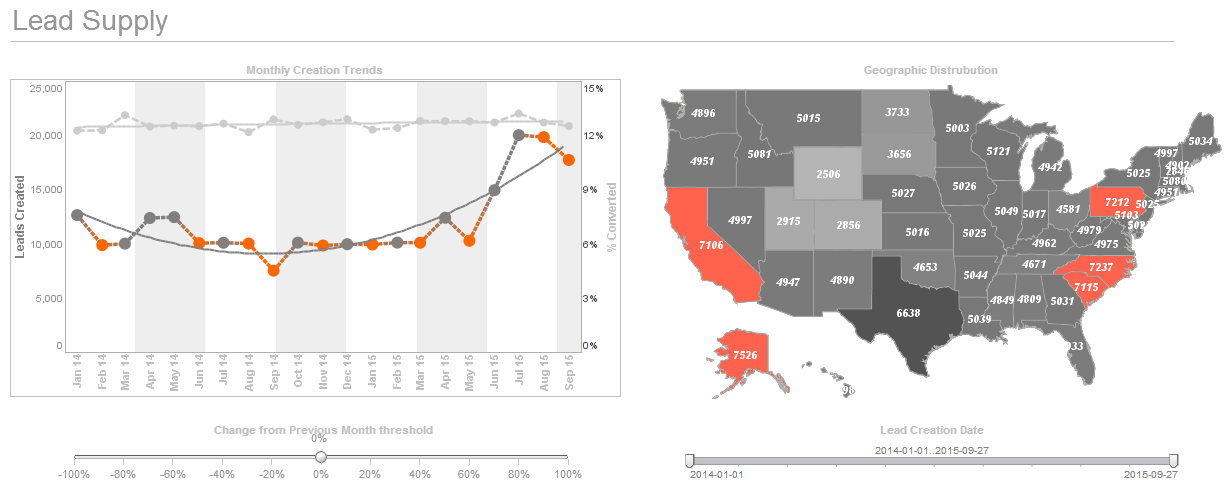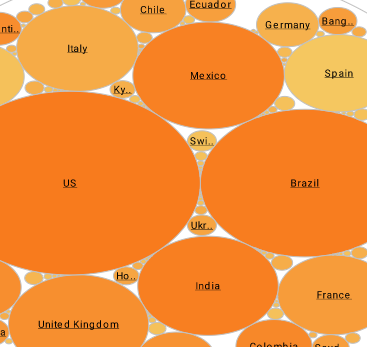Resources & Articles: Business Performance Measurement Tools
Looking for a good business performance measurement tool? Since 1996 InetSoft has been providing innovative software for performance monitoring dashboards that can be easily deployed and used. View a demo and read reviews.
Tangible Return on Investment - So how do companies generate a tangible ROI from business analytics? This is a question that I frequently get from the end users that I talk to. Obviously, for this particular discussion, we are talking about ROI from two different perspectives, again from the perspective of the ultimate end user of the technology, but then also the ROI from the perspective of a software provider looking to add these capabilities. I think Nick did a great job of talking about that type of perspective of ROI and certainly, I would look for any other thoughts that he has on that. But from the end user perspective, when it comes to ROI, it’s obviously something that is difficult to quantify sometimes, but if you look at the legitimately tangible performance improvements that you can create, they are really fall into two different categories: the growth side and the efficiency side...
 |
Click this screenshot to view a three-minute demo and get an overview of what InetSoft's BI dashboard
reporting software, StyleBI, can do and how easy it is to use.
|
Technology, Employees, and Organizations - Now, one of the things that is a bit surprising is that almost as many organizations are using smartphones as are using laptops. Some of the organizations using smartphones who are using Mobile BI are also using laptops and Mobile BI, too. Something else that’s apparent is that the use of all four devices here - laptops, smartphones, tablets and notebooks. The best performance companies have the widest mix. And I think it's clear that many organizations will be using multiple device types for mobile BI for the foreseeable future. So a mobile BI solution that works on multiple devices is going to be key to achieving a successful and uneventful rollout. If we look at smartphones in particular, I think there are probably four points to make. First, despite all the buzz around the Apple devices, one year from now there will still be more organizations using BlackBerry for mobile BI than Apple. And I think that’s true in part due to their strong corporate presence RIM already has and also due to the robust security those devices have already had built in...
Technology for Performance Management - InetSoft’s innovative performance management system and tools have delivered and continue to offer management reporting, scorecards, and dashboards that are easy to configure and deploy. Its business intelligence software platform, StyleBI, focuses on enterprise reporting and performance management...
The Information Value Chain - Companies picking embedded BI approach will have higher levels of user satisfaction when it comes to business intelligence, something that really helps them arm those users with the analytical capability that they need and generate those business opportunities as a result. So what is it that separates these embedded BI users? Why are they achieving these improvements in operational performance and some of those metrics that we just looked at? From a process standpoint, from an organizational maturity standpoint, what are the things that they have in place, what are they more likely to do that enables them to leverage business intelligence to the fullest extent? What are the things that’s interesting, again frequently comes up as correlating with improved performance is the concept that these initiatives are driven by the line of business managers themselves rather than having the technical leaders take the solutions and deliver them to the business users without really understanding what the needs are, the business users are generating those requirements organically and going to IT with, you know hey I need the ability to optimize my trucking payloads, I need all of these different analytical capabilities...
 |
Read how InetSoft saves money and resources with deployment flexibility. |
Tip For Successful Performance Measurement - OK, the last tip for successful performance measurement: we don’t institutionalize the initiative. Okay. When I say institutionalize, what does that mean to you? It’s how you do business, right? It comes woven into the very culture of the organization. And I spent a ton of time thinking about this, folks. And here’s why I think we have a hard time making performance management part of our culture. Number one, we let the budget override the effort. Is that happening in your organization? Is it? As a manager in your organization if you think this entire nation has been driven by the budget office, what’s the embedded message to those managers? What’s that? It could be code speak for cuts, what else? If you don’t hit your mark, what? There could be financial consequences, right? You’re sending an incorrect message to your managers, folks, because they believe that if this is a budget game, it’s all about efficiencies and cutbacks, and if they do not hit their mark, there will be cuts. So guess what’s going to happen? They are always going to hit their mark. Have you seen this? Yeah? Are they sand bagging...
Tips for Selecting the Right Marketing KPIs - You can't improve what you don't measure. The first step to driving growth is understanding which marketing KPIs (key performance indicators) you should track. But with all of the options out there, how do you choose the right metrics for your business? Here are 20 tips to help you select the most important KPIs for your business. 1. Make sure your KPIs are measurable It's important to select KPIs that you can actually measure. There's no point in tracking a metric if you can't accurately track and report on it. When in doubt, err on the side of simplicity and choose a KPI that you can easily track and report on without too much hassle. Measuring KPIs involves more than just data collection. You also need to have a way to analyze and interpret your data so that you can take actionable steps to improve your marketing efforts. Make sure you have the tools and resources in place to properly measure and analyze your KPIs before you start tracking them...
The Top 5 Applications Mac Users Need for 2024 - Apps make using your computer easier. Some of them interconnect different MacBooks, allowing multiple users to use the same app without needing to install it on each computer. Applications boost consistency in operations, leading to higher productivity. They save money, time, and a lot of company resources. Apple's Play Store features a large variety of apps for Mac. They include apps for editing music and videos, cleaning computers, and creating designs. There are apps for communication, enhancing security, and marketing. With almost two million applications in the Apple Store, choosing the best is nearly impossible. Check out these top 5 Mac apps to make your work easier. A business that has hired about 10 employees might have 1,900 passwords. These could be passwords used on enterprise-level applications only. Each individual might have another 12 or more passwords. 2024 might not be easy when it comes to managing passwords. However, it can be easier with 1Password...
Top 10 BI Mistakes - InetSoft presents to you a special webinar on the top 10 business intelligence mistakes that organizations commonly make. What I am going to talk about is some of the dumber things I have seen organizations do when they are trying to measure performance, and I've narrowed it down to these top ten business intelligence mistakes. There are more than that, but I am only going to talk about ten! And this is not going to take the full time that we have on the schedule so I have time for questions if you want to discuss any of these things or challenge my opinions about these things feel free. By the end of the session I’ll probably manage to offend just about all of you, so just be warned! So the first big mistake that I’ve seen companies make is when they measure most of their performance on the past, lagging indicators in the process. They are judging the health of our enterprise by looking at the past...
 |
View a 2-minute demonstration of InetSoft's easy, agile, and robust BI software. |
Top Performance Dashboard Demo - Are you looking for a demo of the top performance dashboard software? Since 1996 InetSoft has been making dashboard software that is easy to deploy and easy to use. Build self-service oriented dashboards quickly. View a demo and read customer reviews from some of the 3,000+ happy customers...
Tool for Monitoring a Marketing Budget - Most businesses can have trouble when it comes to monitoring their marketing spend, and this is mostly because of a lack of budget organization in the company. Although this might seem like an easy problem to solve, letting it go on without doing anything may harm your marketing and sales approach, especially nowadays when everyone's average marketing spend increases almost every year. If you don't organize your budget immediately, you might have difficulty monitoring your additional marketing expenses for the year. It may even cause you to lose money on marketing instead of using it to gain more revenue. As a rule of thumb, marketing strategies should start with a clear and well-informed budget. If you can't come up with a value, you can use historical data from your company or competitor analysis. This will help you understand how much you should set aside for your marketing campaigns. It's also important to continue monitoring your expenses as the year goes by. Doing so will allow you to see how well your strategy is performing and make changes whenever necessary. Here are some ways to effectively monitor your company's marketing budget...
Tracking and Improving Performance Measures - I ask myself what that business is doing today. Organizations should always be trying to improve their current status and capabilities. Most organizations are currently at a level one capability, meaning the level of measuring productivity. They would measure themselves, and they’d be at level one. The level one capability has a level one technical capability so ultimately the production is in the people and the knowledge at the given level. What I’d like to see though are the results from improvements. So there is an improvement paradigm here that says I want to target two or three years out to get to this level. It’s necessary that you ask yourself what the measurements and results are, and make some recommendations on how to make basic changes in the way business is done. Using a real life example on how to use performance measurements to show the view of what the world would like in the new business scenario, we’ll work with carriers and ships. The FAA has a traffic flow management system around the country. Their plan helps traffic flow ease in the air, but they hate it when there are issues with traffic flow. In those situations, it seems appropriate to find ways and prepare for similar future problems. These things make me prefer being on the ground than flying in a congested air space...
Tracking the Performance of Lead Distribution and Routing - Managing prospective customers, a.k.a. leads, is a fundamental pillar of a successful business operation in today's fiercely competitive digital marketplace. This process is divided into two crucial components - lead distribution and lead routing. Both aspects play a significant role in enhancing sales success and require systematic performance tracking. Advanced software technologies have revolutionized this process, making it an accessible and efficient tool for businesses. Let's explore these interesting paradigms and their vital role in modern business practices. Lead distribution implies the assignment of potential customers or leads to the various members of a sales team. The proficiency of this distribution can greatly impact a business's financial performance, emphasizing the importance of robust lead distribution software. Llead distribution software transcends the purpose of a digital registry. It is a powerful tool, ingeniously designed to assign leads based on a set of predefined criteria. This ensures a balanced distribution across your sales force...
Tracking Test Results from Your Staging Environment - The staging environment acts as a bridge between development and production. It's a testing ground where everything from minor updates to major overhauls are evaluated. But how do you ensure that the changes made in your staging environment are ready for the live world? The key lies in the effective tracking of test results. Before delving into tracking methodologies, it's essential to understand what a software staging environment entails. A staging environment is a replica of your production environment where all the final tests are conducted. It's the last stop before your software goes live, making it an important phase for identifying and fixing issues. In this controlled setting, developers and QA teams can simulate real-world conditions, identifying potential problems before they impact end-users. The staging environment also serves as a platform for performance evaluation, ensuring that the software operates smoothly under various conditions. This phase not only tests the functionality of new features but also assesses the overall stability and usability of the software. Setting Up Your Tracking System The first step in tracking test results is to establish a robust system. This involves: #1 Integration of Tracking Tools Integrating tracking tools like Matomo into your staging environment is essential for automated and efficient monitoring. These tools enable seamless tracking across different stages of development, from staging to production...
Transitioning into Collaborative Scorecards - So what I did was find an overall approach to it in order to continue collaborating in an organization’s business model, performance model, and used data sets to create a business path. Regarding the people aspect of creating a business strategy, you have to ask what your current state is and where you would like to go with everyone in your organization. Additionally, the governance policies that are present in the business world require you to have a strategic scorecard and roadmap. Whether that business path is improving some number by 15% in your organization or adding new performance methods, somebody is always watching them, whether it’s a governor or somebody else. There is always somebody doing oversight and policy and so this enterprise architecture concept tells you where you want to be in four or five years down the road. So the initial vision is figuring out an agenda and seeing where the gaps are located. Then you ask yourself, how do we get it done? How do you use performance measurements and some high level tracking system to get it done? In this process, I am tracking the innovation and getting those strategic transformations into somebody’s action plan, whoever is responsible for them. Afterwards, it would grow and ultimately become part of the organization. This would obviously be all done using technology to get people online to do it...
Twelve Service Center KPIs - First Response Time How quickly (in minutes and seconds) an agent responds to their first time a customer contacts the center with anissue. 2. First Call Resolution The percentage of customers having their issue resolved during the first phone call into customer service divided by the total number of resolved issues in a period (day, week, or month). 3. Average Handle Time Time spent on customer calls divided by number of calls answered in the same period of time. It does not include ring and queue time. 4. Average Speed of Answer The the total waiting or hold time divided by the total number of answered calls during the same period of time. 5. Abandon Rate The percentage of calls where the customer hangs up before resolution or conversation closure. 6. Call Transfer Rate The percentage of calls that need to be transferred from one agent to another...
Understanding and Learning Corporate Performance Management - The knowledge assets that are available can be hard to rank and rate because of an influx of information. In any large organization, they will have tremendous knowledge assets, especially if we add in web-based assets. Ranking and rating content is extremely important. Normalizing ranking and rating is one of the challenges. Something like Google, for instance, ranks content based on a very simple rhythm. It’s called their page rank checker, but that’s only appropriate for one type of content and we all know that anybody who gets 57,000 hits on a search knows that the ranking system is being used to sort large amounts of content to make it easier for humans to search through the information. We can be much more effective in terms of the ranking and rating of the information if we’re able to employ semantic models that take into account why the metrics have been selected, how they related to each other, what the knowledge assets are, and how they relate to each other. In simpler cases, we can use a very simple data mining tool that can be tuned to a particular organization and its particular needs...
 |
Read how InetSoft was rated as a top BI vendor in G2 Crowd's user survey-based index. |
University Graduation Metrics - The University Graduation Metrics dashboard below is an example of InetSoft's easy-to-use and interactive dashboard solution. By amalgamating a collection of visuals into one dashboard, InetSoft's software combines prestige with power for users of any industry, education included. The interactive application below demonstrates the degree stats of the made up Lingonberry University from 2005 to 2009. With multiple filtering options like the year, school type, and degree, users can take advantage of data mashup capabilities to compare and analyze different statistics. Comparing and analyzing is made easy at InetSoft with our large collection of charts, like the area graph and bar graph shown below, and our user-friendly interface that features easy drilling tools for closer observation. The capabilities of InetSoft's visualization softwareare is top-notch and can be used easily by anyone looking to create dashboards, reports, or visuals while maintaining a focus on elevating organization efficiency, effectiveness, and long term goals...
Using KPIs to Monitor Usage and Make Improvements - Even at a simpler level that tracking usage by person, you should be asking questions about usability of your KPI software. Are the ways that these dashboards are presenting these key performance indicators, are they being presented in a useful way? It’s one thing to do a short survey or just talk to your dashboard users, it’s another to create metrics on them. How many clicks does it take to for somebody to get to a particular metric? Are people spending more time really looking for information rather than using the information. That’s a great indicator of a well-designed performance management system. Are people trying to refresh their metrics to get the latest data, and then they are giving up and close the dashboard because it takes too long to load. So all sorts of very specific BI usage metrics about the use of the metrics software can be used to make their dashboards more effective. We’ve added a great deal of emphasis on this in our latest release. We’ve added a usage monitoring facility in our BI and performance management application. In a lot of cases, whether it was IT or the business that drove the initial roll-out, sometimes emphasis is placed on certain metrics and certain data elements. The monitoring capability can tell you that those elements that you put most of the emphasis on are or aren’t being utilized. And conversely you can learn what data or dashboards people are using the most that might lead to surprises or point to areas for future development...
Using Data, Not Strategy Maps - Although strategy maps can be a useful tool in organize a business, it comes without substantial data and more possibilities without solid conclusion. Number six. I know I am going to offend some of you on this one. Strategy maps, I think for the most part, are a waste of time. What they are good at is generating consultant billable hours. So if you are a consultant, you love strategy maps because that means you are going to have a lot of meetings and draw in a lot of circles and arrows on flip charts and ultimately sending out a lot of bills to your customers. The problem with strategy maps is that not everybody knows what it is. Will you start from the end and try to achieve a specific sales growth or will you want to achieve a certain target and work back from it and slot the measures into your categories or whatever sounds logical? The problem with the best majority that I’ve seen is that there is no data supporting any of those arrows that are drawing on the boxes. They say, well I think in order to get this increased loyalty from our customers we need to reduce the defects in this. To get that to happen, we need to improve employee morale. In order to raise employee morale, we need to do more training so everybody sees it. The best way to do that is to create a team. I’ve been in the business for 20 years and I’ll say it sounds good to me but the thing is nobody checks these assumptions and all these arrows are based on assumptions, not on data...
 |
Read the top 10 reasons for selecting InetSoft as your BI partner. |
Warehouse Management KPIs - Warehouse management can become very difficult if you aren't properly handling each process. They must be properly devised and their performance must be evaluated regularly. But there can be hundreds of processes to evaluate and it might become tedious. So, it is best to develop a KPI (Key Performance Indicator) for warehouse management that can measure how every process is performing and achieving its goals. These are the important KPIs you need to apply in your warehouse to actively measure and evaluate the processes. Major KPIs of a Warehouse are: Inventory KPI Receiving KPI Putaway KPI Order Management KPI Safety KPI. A warehouse is for stocking products which are known as inventory. The inventory KPI deals with how much you have stocked and how much is being dispatched. So, the important KPIs in inventory are: Inventory Accuracy - The products present in the warehouse must match the products tracked by the inventory tracking system. If there is a mismatch, it means that there is a miscalculation, theft, damage, or any other fault from the supplier. So, this Inventory accuracy helps to find out the difference between the physical stock and the tracked stock...
Website Engagement Metrics Online Businesses Need to Track and Analyze - Every online business that strives for visibility and conversion must understand and analyze website engagement metrics. These numbers provide insights into the effectiveness of marketing strategies and reveal user behavior and preferences. This article explains two crucial aspects of digital analytics: measuring the success of affiliate marketing efforts and tracking overall online engagement. Each domain has its set of Key Performance Indicators (KPIs), which can significantly contribute to a business's growth and success when monitored and analyzed correctly. You'll often encounter various engagement metrics when exploring business growth case studies. These metrics are essential in evaluating how users interact with a website or platform, providing insights into user behavior, content effectiveness, and overall engagement. They demonstrate the extent to which users are involved with your content and can be crucial indicators of the potential for business growth...
What Are Different Types of Campaigns That Could Be Tracked? - Digital Marketing Campaigns: Paid Advertising Campaigns: These encompass PPC (Pay-Per-Click) campaigns on platforms like Google Ads, social media advertising on platforms like Facebook or Instagram, display ads, and sponsored content. Email Marketing Campaigns: Tracking metrics like open rates, click-through rates (CTR), conversion rates, and unsubscribe rates helps gauge the effectiveness of email campaigns. Content Marketing Campaigns: This involves tracking engagement metrics for blog posts, videos, infographics, etc. Metrics include page views, time on page, social shares, and conversion rates. Search Engine Optimization (SEO) Campaigns: Monitoring keyword rankings, organic traffic, bounce rates, and backlink acquisition helps measure the success of SEO efforts. In the digital age, tracking these campaigns is essential for optimizing marketing budgets and ensuring resources are allocated to the most effective channels. Social Media Campaigns: Awareness Campaigns: These focus on increasing brand visibility and reach. Metrics to track include impressions, reach, and engagement (likes, comments, shares). Lead Generation Campaigns: Measuring click-through rates to landing pages, form submissions, and conversion rates are critical for evaluating the success of lead generation efforts...
| Previous: Tracking Business Performance Indicators |
Next: Industry KPI Resources
|



